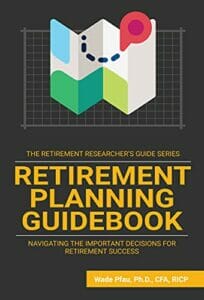Written By: Dr. Barbara O’Neill, CFP®, AFC® Owner/CEO, Money Talk Financial Planning Seminars and Publications
 I recently read Retirement Planning Guidebook, a 453-page tome by retirement researcher and American College professor Dr. Wade Pfau, cover to cover. As an age 60+ adult and a CFP® professional, I consider myself fairly well informed about retirement planning topics. Nevertheless, there were still many valuable insights.
I recently read Retirement Planning Guidebook, a 453-page tome by retirement researcher and American College professor Dr. Wade Pfau, cover to cover. As an age 60+ adult and a CFP® professional, I consider myself fairly well informed about retirement planning topics. Nevertheless, there were still many valuable insights.
Whether you read this book completely, as I did, or use it as an “as-needed” desk reference, Dr. Pfau’s guidebook is a very valuable resource.
Below are some useful “nuggets” that I took away from each of the 13 chapters:
Chapter 1 – Saving money for retirement and later withdrawing money from savings is like climbing a mountain. The goal of mountain climbing (i.e., retirement planning) is not just making it to the top of the mountain (i.e., saving enough money) but also getting back down safely (i.e., spending assets in a sustainable manner throughout a person’s lifetime).
Chapter 2 – There are three major risks in later life: longevity risk (potential life spans are uncertain with a chance of outliving one’s assets), market and sequence-of-return risk (volatility and a downturn at the onset of retirement), and spending shocks (e.g., health care, long-term care, inflation, death of a spouse, family responsibilities, and divorce).
Chapter 3 – Three tricky retirement expenses to project in advance are health care, housing, and taxes and the four Ls of spending in later life are Lifestyle, Longevity, Legacy, and Liquidity. Having a strong social support system may reduce the need for large expenses for health care, long-term care, and other shocks.
Chapter 4 – There are four ways to mitigate the aforementioned risks associated with retirement spending: 1. Spending less, 2. Flexible (decreased) spending during market downturns, 3. Reducing the sensitivity of spending to portfolio volatility, and 4. Strategically withdrawing money from buffer assets (e.g., a money market fund) during downturns.
Chapter 5 – Cash refund and period-certain annuity provisions are popular in practice because, psychologically, many people feel it is unfair to receive little back from a life-only annuity if people die young. The amount of savings placed in an annuity should support longevity goals beyond other reliable income streams (e.g., a pension and Social Security).
Chapter 6 – Claiming Social Security benefits can be done independently from when someone decides to stop working. This decision should be made as part of an overall plan that can include a “delay bridge” coordinated with investments. Beneficiaries who continue to work may receive higher benefits if their earnings are higher than in earlier low-earning years.
Chapter 7 – Approximately 5% of Medicare recipients pay income-related monthly adjusted amounts (IRMAA), an above-baseline level premium for high-income earners. Later life spending often looks like a “smile” when plotted on a graph with high spending at the start of retirement, followed by reduced spending, and increased expenses at the end of life.
Chapter 8 – Long-term care (LTC) is a big unknown. About half of retirees may not have any LTC expenses while a few outliers could spend over $1 million. Three triggers for LTC are accidents, chronic illnesses, and conditions such as Alzheimer’s disease. Four payment options are self-funding, Medicaid, traditional LTC insurance, and hybrid policies.
Chapter 9 – Downsizing is not a “given” in later life. In fact, one study of older adults found that 30% upsized to a larger home. Decisions to move to a new location should not be taken lightly and require due diligence. For example, visiting or renting in an area during different seasons. This saves the expense of undoing a less-than-satisfactory relocation.
Chapter 10 – Tax-efficient distributions, tax diversification, and tax bracket management can prolong the sustainability of retirement savings. Following a spouse’s death, the surviving spouse can receive a couple’s (up to $500,000) exclusion of long-term gains from the sale of a home for two years. Tax issues for affluent retirees with multiple income streams to beware of include IRMAA, required minimum distributions (RMDs), and the net investment income tax (NIIT).
Chapter 11 – Asset titles and beneficiary designations always take precedence over property distribution language in a will. Agents named in legal documents (e.g., executor, power of attorney) should be consulted first. If someone does not have a trusted person to ask to serve, “it may be best to allow the guardianship process to play out with court supervision.”
Chapter 12 – Retirement is a time for people to do whatever they want, including working if this makes them happy. Besides financial security, other aspects of a happy retirement are a sense of purpose/passion, strong relationships, and a healthy lifestyle. If people stop working, key challenges are loss of work identity and an increase in unstructured time. A traditional retirement with a complete work stoppage may not be good “if what you do is who you are.”
Chapter 13 – This chapter provides a summary of action steps from the previous twelve chapters and a list of “trigger” ages for major retirement planning decisions (e.g., 62 for early Social Security benefits and 72 for RMDs). It also notes the need for specialized planning by early retirees such as those practicing Financial Independence, Retire Early (FIRE).
Again, I highly recommend this well-written book, especially for people in the second half of their financial life.